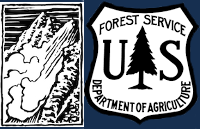Nick Bilton uses the Yamaha as a wind break as he belays me over to a cornice. Strong winds loaded a slope below us which avalanched earlier in the day. Lots of powder from last weeks storms is being blown onto leeward slopes. Photo: Doug Chabot
08-09
This pit was dug on the flanks of the slide. It avalanched on large faceted grains on an ice crust. This crust is on many south to east facing slopes. This slope was triggered by a snowmobiler near the bottom of the hill in the flats.
Not only did the slide oull out near the Lulu Pass, it also appears to have avalanched another slope further east sympathetically.
This avalanche was triggered by a snowmobiler from relatively flat terrain at the bottom of the slope, It ran 1200\' vert by 600\' wide, averaging 2-3 feet deep. It\'s a SE aspect at 10,000\' and failed on facets on an ice crust.
We got widespread collapsing and cracking in the upper meadows. The weakest layer is the facets on the ground. Stability tests=CT11,Q2x2; ECTN, 12. We skied 25-28 degree slopes because we were worried about triggerring a slide. Photo: Chabot
A slab avalanche on a SE facing aspect, off the flanks of Mount Fox around 10,000\'. The size was around 80\' wide, with a crown of 2-5\' and ran around 600\' vertical. Cross loading seemed to be the culprit. Photo: Beau Fredlund
Natural avalanche activity. Slides are 1-3 feet deep and 30-50 feet wide. Photo by Beau Fredlund.
GNFAC Avalanche Advisory for Wed Nov 5, 2008
Whether you are skiing, riding, climbing, or hunting, use the same diligence and preparation you’d use mid-winter. This means carrying rescue gear, traveling with a partner, and only traveling one at a time in avalanche terrain. We’ve seen people get caught, injured, and killed in avalanches during this time of year. The avalanche doesn’t have to bury you to be a threat, because it can sweep you off a cliff, run you over rocks, or into trees to cause injury.
A SPECIAL CAUTION TO HUNTERS:
This extended column test easily failed and propagated a fracture indicating unstable conditions (ECTP 15). Weak faceted crystals have been heavily stressed by new snow that has nearly doubled the snowpack depth. Many slopes have a similar snowpack.
